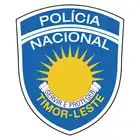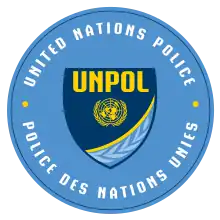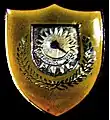| National Police of East Timor Polísia Nasionál Timór Lorosa'e Polícia Nacional de Timor-Leste | |
|---|---|
 Badge of the National Police of East Timor | |
| Abbreviation | PNTL |
| Motto | Servir e Proteger Serve and Protect |
| Agency overview | |
| Formed | 10 August, 2001 (as East Timor Police Services) |
| Preceding agencies |
|
| Legal personality | Police service |
| Jurisdictional structure | |
| National agency | East Timor |
| Operations jurisdiction | East Timor |
| Size | 5,773 sq mi (14,950 km2) |
| Population | 1,261,407 |
| Governing body | Ministry of the Interior |
| Constituting instrument |
|
| General nature | |
| Operational structure | |
| Headquarters | Quartel Geral da PNTL. Rua, Jacinto de Cândido, Dili, East Timor |
| Police officers | 4,165 (2018)[2] |
| Elected officer responsible |
|
| Agency executive |
|
| Units | 12
|
| Website | |
| www | |
The National Police of East Timor (Tetum: Polísia Nasionál Timór Lorosa'e, Portuguese: Polícia Nacional de Timor-Leste) or PNTL is the national police force of East Timor.
History
The PNTL was established in May 2002 by the United Nations, before sovereignty was passed to the new state, with a mandate to provide security and maintain law and order throughout the country, and to enable the rapid development of a credible, professional and impartial police service. Recruitment drives were conducted in early 2000, and basic training commenced on 27 March 2000, under the auspices of the United Nations Transitional Administration in East Timor (UNTAET). On 10 August 2001, the East Timor Police Service was officially established, working alongside CivPol, the United Nations Civilian Police Force. It later changed its name to the Timor-Leste Police Service, before finally adopting its current title of the Policia Nacional de Timor-Leste.
It was not until independence, on 20 May 2002, that an agreement was signed outlining the terms and timetable for handing over of full policing duties from CivPol to the PNTL. The PNTL finally assumed responsibility for the whole country on 10 December 2003.
Controversy
There are accusation that some PNTL officers have tortured prisoners who have been arrested.[3]
In August 2017, the PNTL is criticized by Fundasaun Mahein for allowing its officers to be visible with heavy weapons since it undermines the force's community policing strategy.[4]
Organization
There are at least three special units within the PNTL: the Police Reserve Unit, formerly the Rapid Deployment Service; the Border Patrol Unit (Unidade de Patrulhamento de Fronteiras, UPF); and the Rapid Intervention Unit, or UIR, modelled after the Portuguese National Republican Guard riot police, which served in East Timor before its independence.[5]
Equipment
Firearms
Gallery
 National Police of East Timor officers
National Police of East Timor officers National Police of East Timor officers
National Police of East Timor officers Armoured cars of PNTL
Armoured cars of PNTL Police station at Bobonaro Village
Police station at Bobonaro Village
Historical police emblems
 Police patch during Indonesian occupation
Police patch during Indonesian occupation Patch of United Nations Civilian Police in East Timor
Patch of United Nations Civilian Police in East Timor Police patch used during United Nations administration
Police patch used during United Nations administration Former badge of the post-independence National Police of East Timor
Former badge of the post-independence National Police of East Timor
References
- ↑ United Nations Transitional Administration Administration in East Timor. "Regulation No. 2001/22: On the Establishment of the East Timor Police Service" (PDF) – via peacekeeping.un.org.
- ↑ Direção Geral de Estatística. Timor-Leste em Números, 2018 / Timor-Leste in Figures, 2018 (PDF) (in Portuguese and English).
- ↑ "E Timor Police 'Torture Suspects'". BBC News. 20 April 2006.
- ↑ https://www.fundasaunmahein.org/2017/08/09/pntl-officers-should-carry-appropriate-weaponry-2/
- ↑ "Ramos Horta Calls for Death Squad Claims Probe". Partido Democratico Timor-Leste. ABC/AFP. 23 May 2006. Retrieved 30 May 2021.
- 1 2 3 4 5 Robert Muggah and Emile LeBrun, ed. (October 2010). Timor-Leste Armed Violence Assessment Final Report (PDF). Special Report No. 12. Small Arms Survey. p. 17. ISBN 978-2-940415-43-4. Archived from the original (PDF) on 17 July 2016.
External links